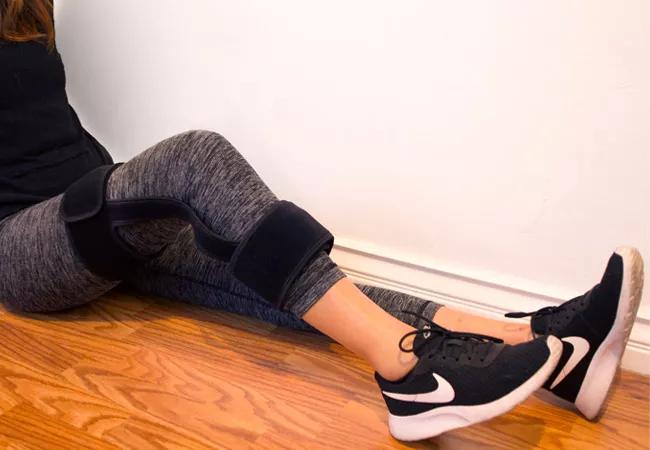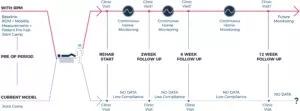App, with smart knee sleeve, stores and shares key data points about a patient’s rehabilitation

A feasibility trial conducted at Cleveland Clinic validates a new remote patient monitoring (RPM) system for patients under 80 who were discharged home following total knee arthroplasty (TKA), according to a study published recently in the Journal of Arthroplasty.
Advertisement
Cleveland Clinic is a non-profit academic medical center. Advertising on our site helps support our mission. We do not endorse non-Cleveland Clinic products or services. Policy
Approximately 90% of recovery from TKA occurs outside the clinic, when a patient’s activity level and exercise regimen play a significant role in the rehabilitation process. The proprietary RPM system from FocusMotion gives patients real-time motion feedback through an avatar, charting progress made each day, and sends users notifications reminding them to exercise or take the weekly self-assessment. This innovation may provide several benefits to patients, providers and payers, including increased patient engagement with rehabilitation, better insight into negative outcomes, and a cost-effective and user-friendly means to collect, store and share the information.
“Traditionally speaking, we receive very little objective data to indicate how our patients are recovering after discharge,” states Brendan Patterson, MD, Chairman of Cleveland Clinic’s Department of Orthopaedic Surgery. “Insights into the patient experience of rehabilitation from TKA might help shape future therapies and interventions, and could give us a better handle on the ultimate value of TKA.”
In the trial, patients (N = 25) downloaded an RPM application to their personal iOS devices, wore a smart neoprene knee sleeve during unsupervised exercise once daily, and completed a semistructured interview at three months postop. The study, funded by the Orthopedic Research and Education Foundation, sought to obtain information as to the number of interruptions in data transmission and patient acceptance of the RPM system.
Advertisement
Participants downloaded the app preoperatively, and baseline data was obtained. The knee sleeve was paired with the patient’s iOS device postoperatively—before discharge—and participants were instructed to perform daily rehabilitation exercises and to complete a weekly survey. Two sensors on the knee sleeve transmitted spatial orientation changes, reporting daily compliance with a home exercise program and range of motion (i.e., knee flexion). When combined with the app, the RPM system collected the following additional data points: mobility, defined by number of steps; weekly patient-reported outcomes (PROMs); and opioid consumption, defined as the number of pills consumed in the last week. The patient-facing application gave participants full access to their data, as well as an avatar illustrating the patient’s range of motion while performing the exercise sets.
Results indicate that the RPM system is a valid way to collect, measure, store and transmit patient-related data, from activity levels, to range of motion, to opioid use. There were no technical issues that resulted in data disruptions in the entire 14-week trial period.
All patients indicated that the system was engaging, citing the app’s ease of use, real-time feedback during exercise, and daily notifications as motivating factors. In fact, half of the patients requested additional, incrementally difficult exercises in order to advance their recovery regimens.
In terms of patient-reported outcomes, patient mobility returned to baseline measurements by six weeks postop, and exceeded baseline by 30% at three months postop. Patients generally stopped using opioids by postoperative day 5, according to their responses to the weekly questionnaire. At 62%, daily exercise compliance was more than double the previously reported rate; we suspect that just knowing their exercise performance was being monitored may have contributed to patient compliance, though this was not our intent. Patients reported a mean 39.3-point improvements in patient-reported outcomes at three months. Measured by the knee sleeve, the mean knee flexion of 119° was consistent with measurements taken in the clinic.
Advertisement
“We were surprised by how much the patients engaged with the application and drew motivation to further strengthen their post-operative knee,” notes Prem Ramkumar, MD, MBA, a resident at Cleveland Clinic and the study’s lead author.
Additionally, patients found the RPM system easy to use, rating it 2.6 on a scale of 1 to 10, in order of increasing difficulty. The most commonly reported problem with the RPM system was the need to recharge the knee sleeve every once every three days.
“In one central location on the app, the patient was prompted to do daily exercises, provided real-time range of motion feedback, and visually charted each patient’s compliance with home exercises, opioid usage, knee range of motion, patient-reported outcome scores and mobility for both the patient and the surgeon. All 22 patients who completed the interview at three months reported that they found the experience to be engaging and motivating as they recovered from their surgeries,” says Dr. Ramkumar.

Schematic representing potential paradigm shift in post-operative monitoring of TKA with the RPM system. RPM, remote patient monitoring.
Dr. Ramkumar acknowledges that “the market of remote monitoring is very new and highly dependent on data acquisition to draw more nuanced insights and contribute to diagnostics. As this is only a feasibility study with just 22 patients, more study is required. The next phase of this research is a prospective randomized control trial to determine if patients using this RPM system need to be seen as frequently postoperatively as those without the technology.”
Advertisement
“The main takeaway from this study is the validation that remote patient monitoring in orthopaedics is here, today,” states Dr. Patterson. “With the increase in virtual visits and the opportunity to offer Cleveland Clinic’s world class care to more patients, this technology may become essential.”
Dr. Ramkumar has disclosed potential or pertinent conflicts of interest, which may include receipt of payment, either direct or indirect, institutional support, or association with an entity in the biomedical field which may be perceived to have potential conflict of interest with this work. For full disclosure statements refer to https://doi.org/10.1016/j.arth.2019.05.021.
Note: Images repurposed from J Arthroplasty; article in press; Ramkumar P, Haeberle H, Ramanathan D, et al; Remote patient monitoring using mobile health: validation of a wearable and machine learning-based surveillance platform; Copyright 2019, with permission from Elsevier.
Advertisement
Advertisement

Why shifting away from delayed repairs in high-risk athletes could prevent long-term instability and improve outcomes

Multidisciplinary care can make arthroplasty a safe option even for patients with low ejection fraction

Percutaneous stabilization can increase mobility without disrupting cancer treatment

Study shows that postop function is closer to normal than with total hip arthroplasty

A tailored approach combining injections, therapy and preventive care is improving outcomes for patients with elbow OA

Exploring new tools and techniques to improve the diagnosis and treatment of concussions.

How year-round play and cold weather impact young throwers — and what can be done to protect them

Criteria include spinal curve less than 65 degrees, remaining skeletal growth